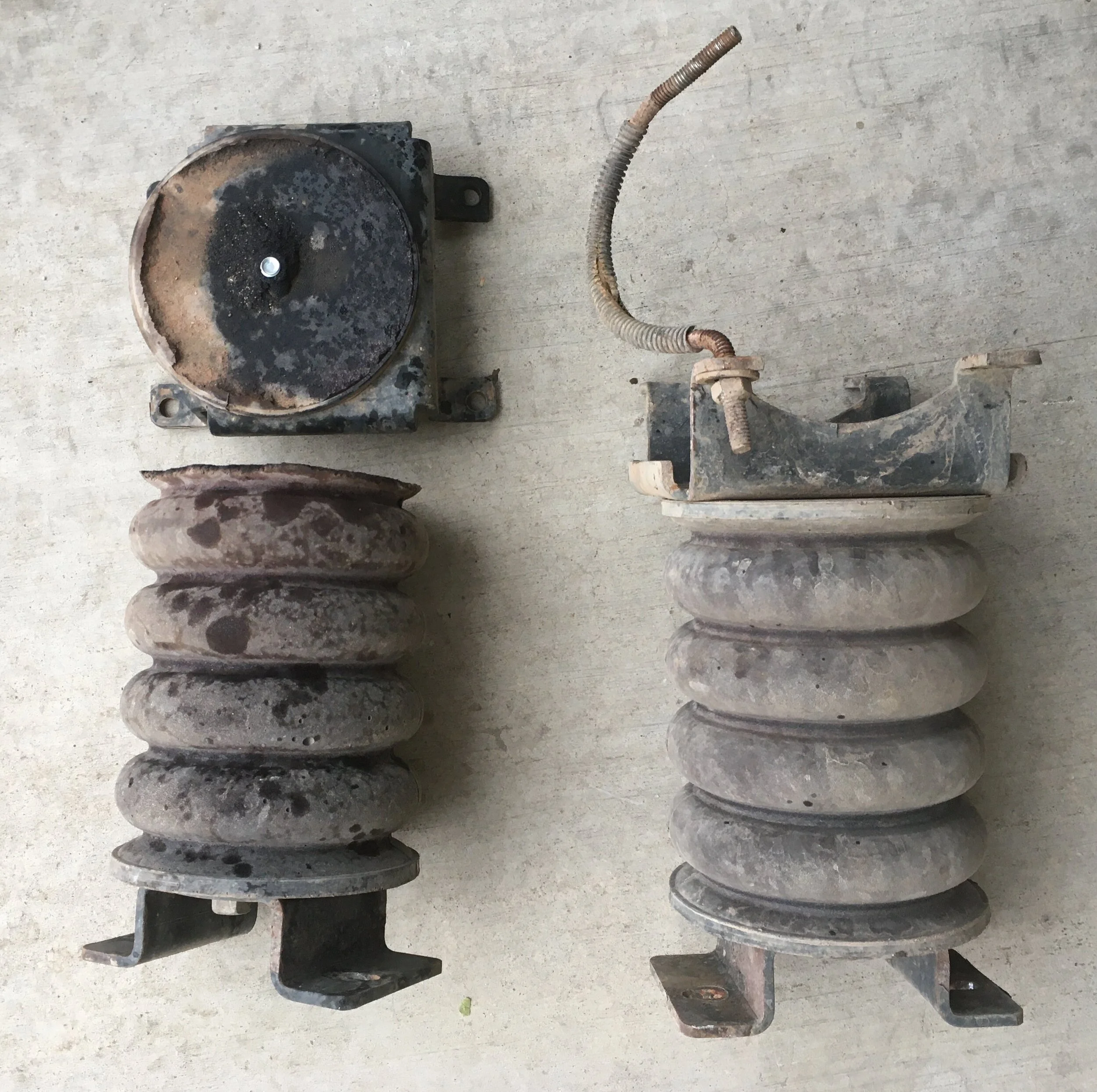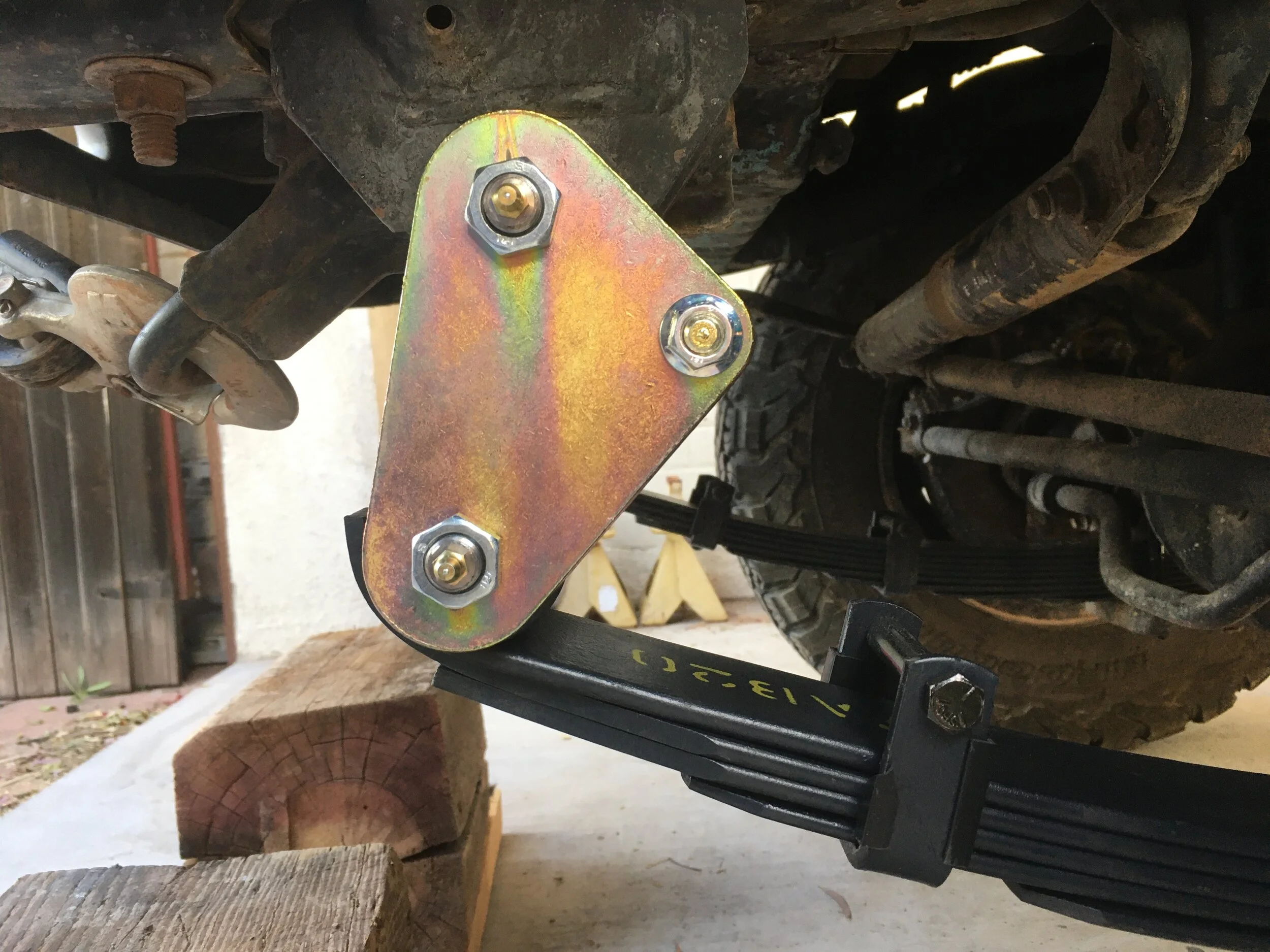Old Man Emu suspension
Let’s be honest: Drivers of newer Jeep Wranglers, first-generation Land Rover Defenders, and Mercedes Benz G-Wagens—all of them equipped with solid axles front and rear but also supple coil suspension—have every right to snicker at the 19th-century leaf springs gracing all four corners of 1984-1999 Land Cruiser Troop Carriers, and the rear axles of Troopies to this day (Tom Sheppard are you reading?).
Did I say 19th century? The first crude “elbow” leaf springs appeared on carriages in France in the 1600s. But the elliptical leaf spring, patented by Obadiah Elliott in 1804, would be recognizable by any Land Cruiser owner today.
Why has Toyota stuck with semi-elliptic leaf-spring suspension for so long on the Troop Carrier and its derivatives, especially when other versions of the Land Cruiser have had all-coil suspension since 1991? Two reasons, essentially: simplicity and cost.
A leaf spring not only performs its primary function of suspending the vehicle, it also locates the axle front to rear and side to side. A coil spring does neither; the axle must be located front to rear by either trailing or leading arms, and side to side by a panhard rod or something similar. This increases complexity and cost and, some would argue, decreases strength and reliability (a notion with which I do not agree.)
Of one comparison there is little doubt: A leaf spring cannot match a coil spring in ride comfort or compliance.
The major reason for this is the combination of interleaf stiction—which resists the sliding movement of the leaves in the first place—and friction, as, once set in motion, each leaf in the spring pack slides back and forth along the underside of the leaf above it with bumps and dips, while the leaf below slides along that one’s underside, and so on—all this in a pack that might have ten or more leaves. Even with brand-new springs still covered in factory paint and grease, interleaf stiction and friction is inevitable. Once the springs are a couple of years old, paint worn off and rust in its place, it only gets worse.
This interleaf friction can have benefits, for example in the event of shock absorber failure—a leaf-sprung vehicle with one or even all of its shocks removed is bouncy but drivable, as the interleaf friction affords a damping effect. A coil-sprung vehicle minus shocks is dangerous, as a coil spring has scant internal stiction or friction. But that’s a microscopic upside.
Thus the challenge facing a suspension designer working with leaf springs is to create a spring that will carry the necessary load, which is easily done by employing more or thicker leaves, while as much as possible reducing stiction and friction to enhance ride comfort, which is easily done by employing thinner or fewer leaves. You see the problem.
When Roseann and I bought our 1993 Troopy, sight unseen, from 6,000 miles away (we in the U.S.; the Troopy in Darwin, Australia) we were fully aware that we were taking chances on numerous aspects of the vehicle’s condition. Mostly that condition turned out to be just fine, aside from significantly more rust than had been advertised. However, after having the vehicle shipped to Sydney, we then embarked on several major modifications, also long distance, some of which worked and some of which did not.
The big one, the Mulgo pop top, met all our expectations, and Daniel at the Expedition Centre was a pleasure to work with. Likewise, the Warn winch and ARB Intensity driving lamps he installed were everything previous experience had led us to believe they would be. Cabinetry Roseann sketched and emailed and which Daniel had fabricated turned out perfect in function and adequate in construction (I would have chosen better plywood and not left poorly filled screw holes so obvious). Daniel installed Recaro seats, a massive improvement on the sagging stock units, and a 90-liter water tank that has been awesome.
After our first Australia trip, across the Simpson Desert via the Madigan Line, it was apparent the existing suspension was inadequate to carry the increased weight of our modifications. I was strongly inclined to go with Old Man Emu as a replacement, having had it on our FJ40 for a couple of decades. But we were nudged toward a company with the modest title of Ultimate Suspension, who provided us with a sophisticated graph of the existing suspension’s performance or lack thereof. They installed a new set of springs and shock absorbers, as well as a set of “Sumo Springs” on the rear axle—an add-on I resisted but was assured would be excellent for helping to support the load.
That suspension definitely supported the load. Compliance? I suspect steamrollers have more. This was especially apparent in the rear, where the Sumo Springs further inhibited axle movement. Since they are nothing but elongated rubber doughnuts, I wasn’t surprised.
Nevertheless, we completed three more trips in Australia and Tasmania on that suspension—mostly. On our last leg, to Perth on the west coast, where we were to container our vehicle, along with Graham Jackson and Connie Rodman’s, for the crossing to Africa, the Troopy developed a mysterious noise amplified through the steering column. Graham and I failed to locate it, but a shop in Perth assured us it was the front springs, even though by then I suspected it was in the steering column itself. They installed a complete new set of front springs just one day before we had to leave the vehicles at the port. As I drove away after paying, the noise was still there (it indeed later proved to be a harmless steering column clunk). I drove back and took the shop manager for a ride. He quickly admitted the wrong diagnosis, but by then it was too late to replace the “old” springs, so we got a large chunk of refund.
On our drive across southern Africa, through South Africa, Botswana, and Namibia, we soon realized the new front springs were even worse than the Ultimate springs. They had far too much arch, so that the shackle angle was completely wrong (it should be at or close to 90 degrees to the spring). Ugh.
Once back home with the Land Cruiser, we stewed over the waste of money but were too busy with other projects Finally, while helping Graham lead a trip through Utah and Colorado, I became terminally annoyed at the reduction in off-pavement capability the Ultimate/Perth suspension was causing, along with the reduction in the compliance of my lumbar disks. Once home, I got under the Troopy, only to find one of the Ultimate shocks, which by that point had perhaps 15,000 miles on it, totally blown, in addition to which one of the Sumo Springs had ripped free of its base plate. As an experiment, I pulled the smallest leaf out of the front springs, which made scant difference in the bad shackle angle or the ride.
Sumo Springs . . . gone!
That did it. After a consultation with Kurt at Cruiser Outfitters, I ordered a complete Old Man Emu suspension system. OME springs are individually specced for load, so I specified heavy in the front, to accommodate the ARB bumper and winch, and Heavy Plus in the rear, to accommodate the cabinetry, pop-top, rear Kaymar bumper, rear Long Ranger 180-liter fuel tank, etc. etc. . . .
The springs came with matched shocks, greasable anti-inversion shackles, a new steering stabilizer, even new bushings and hardware for the ends of the front anti-roll bar (or “stabilizer” bar). Over the course of a weekend I installed everything, then went for a drive. Ten minutes later I came back and put Roseann in the passenger seat. About a hundred yards down our residential street she said, “Wow!” Yeah, the difference was that stark. A hundred-mile trip the next day confirmed the massive improvement in ride and compliance.
Why? Measuring the total thickness of the spring packs at the spring seat (the thickest part), was somewhat surprising: The Ultimate and OME rear springs were exactly the same thickness (9.7cm), as were the Perth and OME front springs (5cm). However, the OME springs employed more and thinner leaves to achieve this thickness—12 versus 11 leaves on the rear, 8 versus 7 in the front. Also, unlike either the “Ultimate” rear or the Perth front springs, OME employs nylon anti-friction pads at the tips of the most normally active leaves. Far from being just a gimmick, I found these to work exactly as advertised on my FJ40, as long as I pried apart the leaf ends and gave each pad a shot of grease every year or so. They also do wear out eventually and must be replaced, so should be considered a maintenance item.
Anti-friction pads are visible here
Unlike the Ultimate springs, the OME springs are also tapered and diamond-cut at the tips, which ARB claims distributes the load over a larger surface area—which would also reduce friction. I have no testing results to back this up, but it is obviously a more expensive way to build a spring leaf so one assumes there is a good reason to do so.
Square-cut, untapered “Ultimate” leaves
Versus diamond-cut, tapered OME leaves
Finally, the greasable shackles contribute a bit to the overall flexibility of the springs. Only the center pin of each bushing is greasable, because the bushing only rotates around that pin, not the outer circumference.
Right now the Troopy sits exactly level (with proper shackle angles), with mostly everything aboard but without the rear fuel tank filled. On our first long trip I’ll do so and evaluate the stance; it’s possible to add another leaf there if necessary. The ride is so much improved that I wouldn’t hesitate to do so if needed.
Greasable shackles . . . and correct angle
And, next time, I’ll listen to my own experience and not be talked into the “Ultimate” solution.









